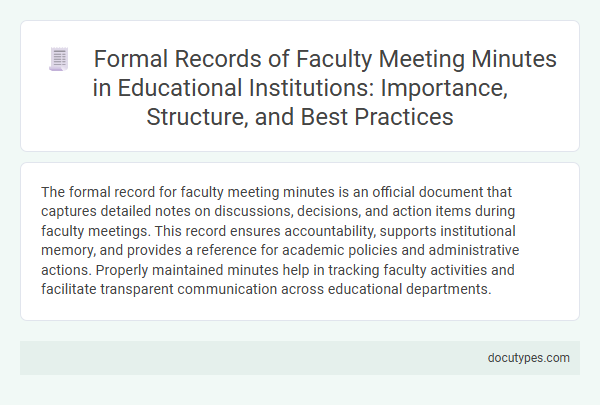The formal record for faculty meeting minutes is an official document that captures detailed notes on discussions, decisions, and action items during faculty meetings. This record ensures accountability, supports institutional memory, and provides a reference for academic policies and administrative actions. Properly maintained minutes help in tracking faculty activities and facilitate transparent communication across educational departments.
Introduction to Faculty Meeting Minutes in Educational Institutions
| Introduction to Faculty Meeting Minutes in Educational Institutions | |
|---|---|
| Definition | Faculty meeting minutes are the official documented records of discussions, decisions, and action items during faculty meetings in educational institutions. |
| Purpose | Serve as a formal record to ensure transparency, accountability, and follow-up on academic and administrative matters discussed by faculty members. |
| Content | Key elements include date, time, attendees, agenda items, summaries of discussions, decisions made, assigned responsibilities, and deadlines. |
| Format | Typically structured with headings, bullet points, and clear labels for each agenda topic to facilitate easy reference and clarity. |
| Responsibility | The appointed secretary or designated faculty member usually prepares and maintains the minutes for institutional records. |
| Importance | Supports institutional memory, aids decision-making processes, and provides evidence of compliance with academic governance policies. |
| Storage | Minutes are archived digitally or in physical form within the institution's administrative office for future reference and audits. |
Significance of Formal Records in Educational Governance
The formal record for faculty meeting minutes serves as an official documentation of discussions, decisions, and action items within educational institutions. These records ensure transparency, accountability, and continuity in school governance by providing a clear reference of faculty deliberations and resolutions. Maintaining accurate and comprehensive meeting minutes supports compliance with institutional policies and fosters effective communication among faculty members and administrative bodies.
Key Components of Faculty Meeting Minutes
Faculty meeting minutes serve as the official record documenting the discussions and decisions made during faculty meetings. These minutes ensure transparency, accountability, and provide a reference for future actions within educational institutions.
- Date and Time - Records the exact date and starting time of the meeting to establish an accurate timeline.
- Attendance - Lists all participants, including faculty members present, absent, and any guests or speakers.
- Agenda Items and Decisions - Summarizes each discussion point, motions proposed, votes taken, and outcomes reached during the meeting.
Legal and Institutional Importance of Accurate Minute-Taking
The formal record for faculty meeting minutes serves as an official and legal document that captures decisions, discussions, and actions taken during meetings. Accurate minute-taking ensures a reliable account that supports institutional governance and accountability.
These minutes provide evidence in case of disputes, audits, or compliance reviews, making their precision essential for legal protection. Your careful documentation helps maintain transparency and supports effective institutional memory for future reference.
Standard Structure for Documenting Faculty Meeting Minutes
The formal record for faculty meeting minutes is a structured document that accurately captures all discussions, decisions, and action items. This record ensures transparency, accountability, and easy reference for future meetings within educational institutions.
- Heading - Includes the date, time, location, and list of attendees to provide clear context.
- Agenda Items - Lists each topic discussed sequentially with corresponding notes and decisions made.
- Action Items and Responsibilities - Specifies tasks assigned, deadlines, and responsible individuals for follow-up.
Roles and Responsibilities in Preparing Meeting Minutes
The formal record for faculty meeting minutes serves as an official documentation of all discussions, decisions, and action items that occur during the meeting. It captures essential information to ensure accuracy and accountability within the educational institution.
Roles and responsibilities in preparing meeting minutes include the designated secretary or note-taker, responsible for accurately recording dialogue and key points. This individual must organize the content clearly, highlighting resolutions and assigned tasks. You must review and distribute the minutes promptly to faculty members to maintain effective communication and follow-up.
Best Practices for Effective Minute-Taking
What is the formal record for faculty meeting minutes? Faculty meeting minutes serve as the official documentation of discussions, decisions, and action items during meetings. These records ensure accountability and provide a reference for future faculty activities and policies.
What are best practices for effective minute-taking? Effective minute-taking involves clear, concise, and accurate recording of key points without unnecessary detail. Using a standardized template helps maintain consistency and enhances the clarity of meeting outcomes for all participants.
How can you improve the quality of faculty meeting minutes? Focus on capturing essential information such as decisions made, assigned tasks, deadlines, and attendance. Reviewing the minutes promptly after the meeting promotes accuracy and allows for quick distribution to relevant stakeholders.
Common Challenges and Solutions in Recording Minutes
Faculty meeting minutes serve as the official documentation of discussions, decisions, and actions taken during faculty gatherings. Accurate recording of these minutes ensures transparency and accountability within educational institutions.
- Incomplete Details - Missing key points can lead to misunderstandings and lack of clarity on decisions made.
- Time Constraints - Recording minutes in real-time often challenges note-takers, affecting accuracy and completeness.
- Lack of Standardization - Inconsistent formatting and structure make it difficult to reference and compare minutes across meetings.
Implementing standardized templates, assigning dedicated minute-takers, and reviewing drafts promptly help overcome common challenges in recording faculty meeting minutes.
Digital Tools and Technologies for Managing Meeting Records
The formal record for faculty meeting minutes serves as an official documentation of discussions, decisions, and action items during academic meetings. Accurate minutes ensure transparency and provide a reliable reference for future administrative and academic purposes.
Digital tools like Microsoft OneNote, Google Docs, and specialized software such as Boardable streamline the process of capturing and organizing meeting records. These technologies enhance collaboration, allow real-time editing, and securely store minutes for easy access and management.
What Is the Formal Record for Faculty Meeting Minutes? Infographic

